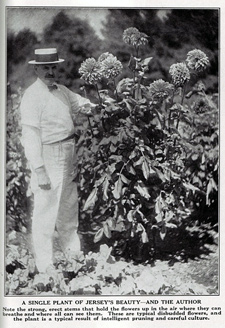Glamorous ‘Jersey’s Beauty’ Dahlia

The Marilyn Monroe and Babe Ruth of twentieth-century dahlias, legendary ‘Jersey’s Beauty’ grows today on the brink of extinction. To urge home gardeners to help save this towering, pink, 1920s classic — and other at-risk summer-blooming bulbs — we’ve named it our very first Heirloom Bulb of the Year for spring planting [in 2003].
The saga of ‘Jersey’s Beauty’ reads a bit like modern-day Tulipomania. It bloomed for the first time in 1921 on a country estate in Rumson, New Jersey, thrilling head-gardener and amateur dahlia-breeder William Waite. At that time, dahlias were the most stylish flower, and soon America’s horticultural in-crowd was buzzing about Waite’s gorgeous new protègè. In 1922 it received an American Dahlia Society score of 98, the highest ever, and in 1923 it was launched into commerce with a magnificent display of 200 blooms massed against black velvet at the New York Dahlia Show. The price was a staggering $25 a tuber, according to Martin Kral in the 1995 Dahlias of Today, enough to buy “fifty gallons of milk — home-delivered, of course — or a man’s new suit, or one of those modern home appliances, a vacuum cleaner.” But every tuber sold. Soon commercial fields of as many as 50,000 plants were reported, prices dropped, and ‘Jersey’s Beauty’ became the star of countless backyard gardens — where it ruled for decades as America’s favorite dahlia.

By the 1990s, though, it had all but disappeared. After a long search, Old House Gardens tracked down some promising stock in France, and owner Scott Kunst eagerly awaited its first bloom. “After years of disappointments and impostors,” he says, “it was great to have finally found the real thing. It was like discovering buried treasure.”
It’s easy to see why ‘Jersey’s Beauty’ was so highly sought-after, and why even the most forward-looking gardener might want to grow it today. In late summer and fall when other plants are winding down, it erupts into a crescendo of bloom, often reaching a dazzling seven feet and offering, Kunst says, “more flowers than you can find a vase for.” Each four-to-six-inch bloom is an exuberant mass of petals arching back from the center, “like pink tongues of flame.” Although over 80 years old, it’s wonderfully healthy and easy to grow.
And that’s the only way to save it, Kunst says. “You don’t need an ark, or federal funding. Just grow it!”











